How Warm Can It Be and Still Snow
Global Warming
June three, 2010
Throughout its long history, Earth has warmed and cooled fourth dimension and once more. Climate has inverse when the planet received more or less sunlight due to subtle shifts in its orbit, as the atmosphere or surface changed, or when the Sun's energy varied. Merely in the by century, another strength has started to influence Earth's climate: humanity.

What is Global Warming?
Global warming is the unusually rapid increment in Earth'south average surface temperature over the by century primarily due to the greenhouse gases released by people burning fossil fuels.
How Does Today'southward Warming Compare to By Climate change?
Earth has experienced climate change in the by without help from humanity. Just the current climatic warming is occurring much more than quickly than past warming events.
Why Practise Scientists Remember Current Warming Isn't Natural?
In Earth's history before the Industrial Revolution, Globe's climate changed due to natural causes unrelated to human activity. These natural causes are nonetheless in play today, but their influence is too small or they occur likewise slowly to explain the rapid warming seen in recent decades.
How Much More than Will Earth Warm?
Models predict that equally the globe consumes ever more fossil fuel, greenhouse gas concentrations will go on to rise, and Globe's average surface temperature will rise with them. Based on plausible emission scenarios, average surface temperatures could rise between 2°C and 6°C by the end of the 21st century. Some of this warming will occur even if hereafter greenhouse gas emissions are reduced, considering the Earth system has not even so fully adjusted to environmental changes we accept already made.
How Will World Respond to Warming Temperatures?
The impact of global warming is far greater than just increasing temperatures. Warming modifies rainfall patterns, amplifies coastal erosion, lengthens the growing season in some regions, melts ice caps and glaciers, and alters the ranges of some infectious diseases. Some of these changes are already occurring.
References and Related Resources
Global Warming
Throughout its long history, Earth has warmed and cooled time and again. Climate has changed when the planet received more than or less sunlight due to subtle shifts in its orbit, as the atmosphere or surface inverse, or when the Sun's energy varied. Only in the past century, another force has started to influence World's climate: humanity
How does this warming compare to previous changes in Globe's climate? How can we be sure that human being-released greenhouse gases are causing the warming? How much more than will the Earth warm? How will World respond? Answering these questions is peradventure the about significant scientific challenge of our time.
What is Global Warming?
Global warming is the unusually rapid increment in Earth'southward average surface temperature over the past century primarily due to the greenhouse gases released as people burn fossil fuels. The global boilerplate surface temperature rose 0.six to 0.9 degrees Celsius (1.1 to i.six° F) between 1906 and 2005, and the rate of temperature increase has near doubled in the last fifty years. Temperatures are certain to become upwards further.
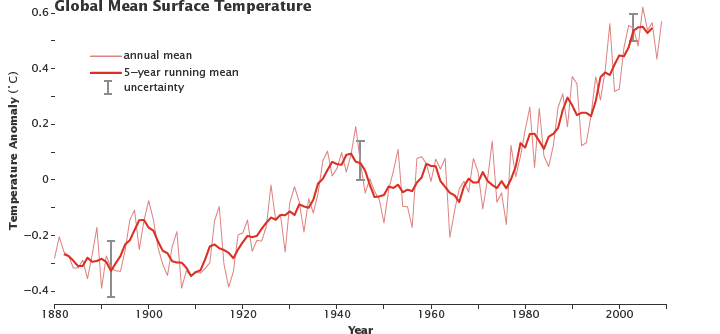
Despite ups and downs from year to year, global boilerplate surface temperature is rising. By the beginning of the 21st century, Earth's temperature was roughly 0.five degrees Celsius above the long-term (1951–1980) boilerplate. (NASA figure adapted from Goddard Plant for Space Studies Surface Temperature Analysis.)
Earth's natural greenhouse effect
Earth's temperature begins with the Sun. Roughly 30 percent of incoming sunlight is reflected back into space by bright surfaces similar clouds and ice. Of the remaining 70 per centum, most is absorbed by the state and bounding main, and the residuum is absorbed by the temper. The absorbed solar energy heats our planet.
As the rocks, the air, and the seas warm, they radiate "heat" energy (thermal infrared radiation). From the surface, this free energy travels into the atmosphere where much of it is absorbed by water vapor and long-lived greenhouse gases such as carbon dioxide and methane.
When they absorb the energy radiating from Earth's surface, microscopic water or greenhouse gas molecules plough into tiny heaters— similar the bricks in a fireplace, they radiate heat even after the fire goes out. They radiate in all directions. The energy that radiates back toward Earth heats both the lower atmosphere and the surface, enhancing the heating they get from direct sunlight.
This absorption and radiation of rut by the temper—the natural greenhouse effect—is beneficial for life on Earth. If at that place were no greenhouse effect, the World's average surface temperature would be a very dank -xviii°C (0°F) instead of the comfortable fifteen°C (59°F) that it is today.
See Climate and World'south Energy Budget to read more than about how sunlight fuels Globe'due south climate.
The enhanced greenhouse outcome
What has scientists concerned at present is that over the past 250 years, humans accept been artificially raising the concentration of greenhouse gases in the atmosphere at an ever-increasing rate, by and large past called-for fossil fuels, but also from cutting down carbon-absorbing forests. Since the Industrial Revolution began in about 1750, carbon dioxide levels have increased nigh 38 percent every bit of 2009 and marsh gas levels have increased 148 percent.
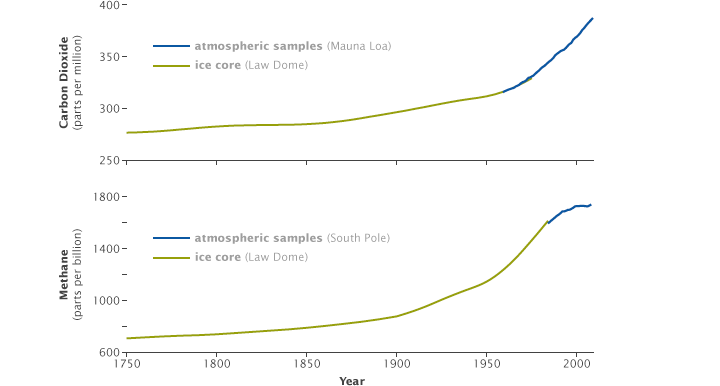
Increases in concentrations of carbon dioxide (superlative) and methane (bottom) coincided with the start of the Industrial Revolution in virtually 1750. Measurements from Antarctic ice cores (greenish lines) combined with direct atmospheric measurements (blue lines) testify the increase of both gases over time. (NASA graphs by Robert Simmon, based on data from the NOAA Paleoclimatology and Earth Organisation Enquiry Laboratory.)
The atmosphere today contains more than greenhouse gas molecules, and then more of the infrared free energy emitted past the surface ends up being captivated by the atmosphere. Since some of the extra energy from a warmer temper radiates back down to the surface, Earth's surface temperature rises. By increasing the concentration of greenhouse gases, we are making Earth's atmosphere a more efficient greenhouse.
How is Today's Warming Different from the By?
Globe has experienced climate change in the past without help from humanity. We know about past climates because of evidence left in tree rings, layers of water ice in glaciers, ocean sediments, coral reefs, and layers of sedimentary rocks. For example, bubbles of air in glacial water ice trap tiny samples of Earth'due south temper, giving scientists a history of greenhouse gases that stretches back more than 800,000 years. The chemical make-up of the ice provides clues to the average global temperature.
Come across the World Observatory's series Paleoclimatology for details about how scientists study by climates.
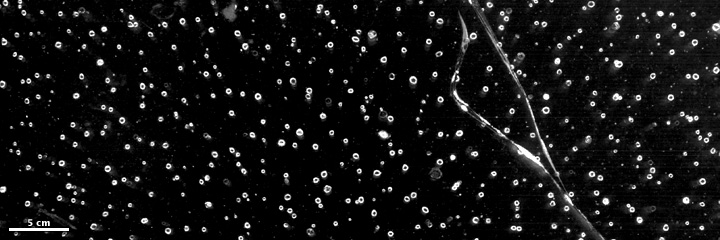
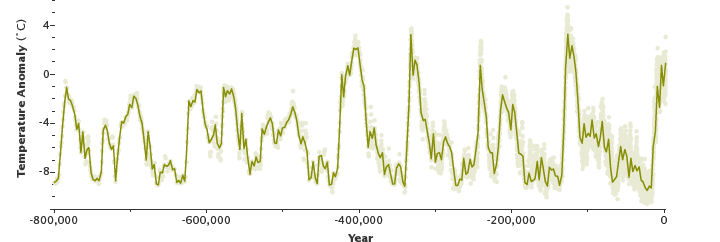
Glacial water ice and air bubbles trapped in it (top) preserve an 800,000-year record of temperature & carbon dioxide. Earth has cycled between water ice ages (low points, large negative anomalies) and warm interglacials (peaks). (Photograph courtesy National Snowfall & Ice Information Center. NASA graph by Robert Simmon, based on data from Jouzel et al., 2007.)
Using this ancient evidence, scientists have built a tape of Globe's past climates, or "paleoclimates." The paleoclimate record combined with global models shows past ice ages besides as periods even warmer than today. Just the paleoclimate record also reveals that the current climatic warming is occurring much more rapidly than past warming events.
Equally the Earth moved out of ice ages over the past million years, the global temperature rose a full of 4 to 7 degrees Celsius over about 5,000 years. In the past century alone, the temperature has climbed 0.vii degrees Celsius, roughly ten times faster than the average rate of ice-historic period-recovery warming.

Temperature histories from paleoclimate data (dark-green line) compared to the history based on modern instruments (bluish line) suggest that global temperature is warmer now than it has been in the past 1,000 years, and possibly longer. (Graph adjusted from Mann et al., 2008.)
Models predict that Earth volition warm betwixt 2 and 6 degrees Celsius in the adjacent century. When global warming has happened at various times in the past two 1000000 years, information technology has taken the planet most 5,000 years to warm 5 degrees. The predicted rate of warming for the next century is at least 20 times faster. This rate of alter is extremely unusual.
Is Electric current Warming Natural?
In Globe'south history before the Industrial Revolution, Globe's climate inverse due to natural causes not related to human action. Almost oft, global climate has changed considering of variations in sunlight. Tiny wobbles in World'due south orbit altered when and where sunlight falls on Globe'southward surface. Variations in the Sun itself have alternately increased and decreased the amount of solar energy reaching Earth. Volcanic eruptions accept generated particles that reflect sunlight, brightening the planet and cooling the climate. Volcanic activity has also, in the deep past, increased greenhouse gases over millions of years, contributing to episodes of global warming.
A biographical sketch of Milutin Milankovitch describes how changes in Earth'southward orbit affects its climate.
These natural causes are still in play today, merely their influence is as well small or they occur too slowly to explicate the rapid warming seen in recent decades. We know this considering scientists closely monitor the natural and man activities that influence climate with a fleet of satellites and surface instruments.

NASA satellites tape a host of vital signs including atmospheric aerosols (particles from both natural sources and human activities, such equally factories, fires, deserts, and erupting volcanoes), atmospheric gases (including greenhouse gases), free energy radiated from Earth's surface and the Sun, ocean surface temperature changes, global sea level, the extent of ice sheets, glaciers and sea water ice, plant growth, rainfall, cloud structure, and more.
On the ground, many agencies and nations support networks of weather and climate-monitoring stations that maintain temperature, rainfall, and snow depth records, and buoys that measure surface water and deep ocean temperatures. Taken together, these measurements provide an ever-improving record of both natural events and human action for the past 150 years.
Scientists integrate these measurements into climate models to recreate temperatures recorded over the past 150 years. Climate model simulations that consider only natural solar variability and volcanic aerosols since 1750—omitting observed increases in greenhouse gases—are able to fit the observations of global temperatures only upward until about 1950. Later that point, the decadal trend in global surface warming cannot be explained without including the contribution of the greenhouse gases added by humans.
Though people accept had the largest touch on on our climate since 1950, natural changes to Earth's climate take as well occurred in recent times. For example, two major volcanic eruptions, El Chichon in 1982 and Pinatubo in 1991, pumped sulfur dioxide gas high into the atmosphere. The gas was converted into tiny particles that lingered for more than a year, reflecting sunlight and shading Earth's surface. Temperatures across the earth dipped for ii to 3 years.
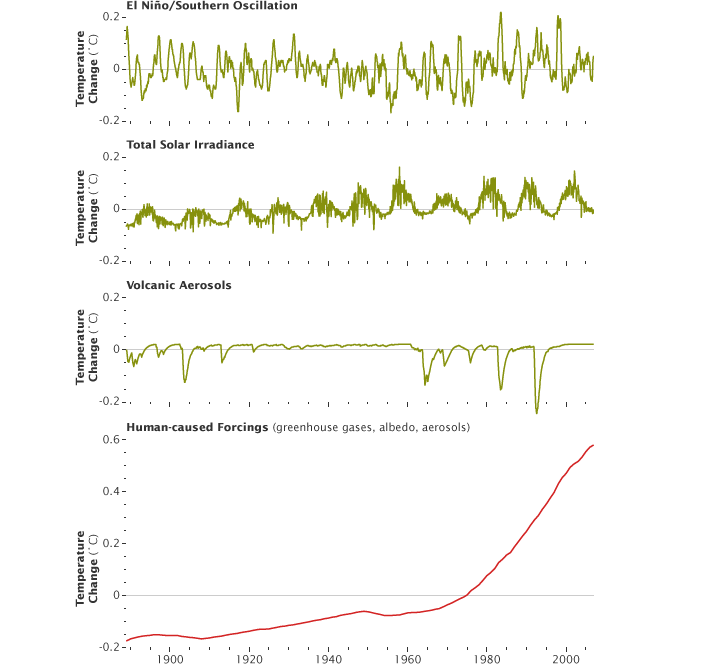
Although World'due south temperature fluctuates naturally, human influence on climate has eclipsed the magnitude of natural temperature changes over the past 120 years. Natural influences on temperature—El Niño, solar variability, and volcanic aerosols—accept varied approximately plus and minus 0.2° C (0.4° F), (averaging to near zero), while human influences have contributed roughly 0.8° C (1° F) of warming since 1889. (Graphs adapted from Lean et al., 2008.)
Although volcanoes are agile around the world, and continue to emit carbon dioxide as they did in the by, the amount of carbon dioxide they release is extremely small compared to human emissions. On average, volcanoes emit between 130 and 230 million tonnes of carbon dioxide per year. By burning fossil fuels, people release in excess of 100 times more, nearly 26 billion tonnes of carbon dioxide, into the atmosphere every year (every bit of 2005). Equally a result, homo activity overshadows any contribution volcanoes may have made to contempo global warming.
Changes in the effulgence of the Sun can influence the climate from decade to decade, but an increase in solar output falls short equally an caption for recent warming. NASA satellites take been measuring the Sunday's output since 1978. The full energy the Sun radiates varies over an 11-year bicycle. During solar maxima, solar energy is approximately 0.1 percent higher on boilerplate than it is during solar minima.
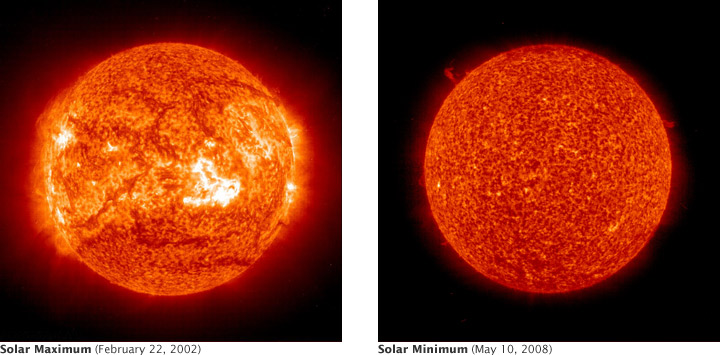
Each cycle exhibits subtle differences in intensity and duration. As of early 2010, the solar brightness since 2005 has been slightly lower, not higher, than it was during the previous 11-twelvemonth minimum in solar activity, which occurred in the tardily 1990s. This implies that the Sunday's affect between 2005 and 2010 might have been to slightly decrease the warming that greenhouse emissions alone would have caused.

Satellite measurements of daily (light line) and monthly average (dark line) full solar irradiance since 1979 have non detected a clear long-term tendency. (NASA graph by Robert Simmon, based on data from the ACRIM Science Team.)
Scientists theorize that in that location may be a multi-decadal trend in solar output, though if i exists, information technology has non been observed as nevertheless. Even if the Sun were getting brighter, however, the blueprint of warming observed on Globe since 1950 does not friction match the blazon of warming the Dominicus lonely would cause. When the Sun'southward energy is at its elevation (solar maxima), temperatures in both the lower atmosphere (troposphere) and the upper atmosphere (stratosphere) become warmer. Instead, observations testify the blueprint expected from greenhouse gas effects: Earth's surface and troposphere have warmed, but the stratosphere has cooled.
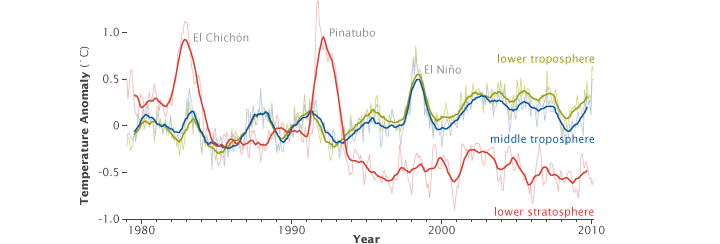
Satellite measurements testify warming in the troposphere (lower atmosphere, light-green line) simply cooling in the stratosphere (upper atmosphere, red line). This vertical pattern is consistent with global warming due to increasing greenhouse gases, but inconsistent with warming from natural causes. (Graph by Robert Simmon, based on data from Remote Sensing Systems, sponsored past the NOAA Climate and Global Change Program.)
The stratosphere gets warmer during solar maxima considering the ozone layer absorbs ultraviolet light; more ultraviolet light during solar maxima means warmer temperatures. Ozone depletion explains the biggest part of the cooling of the stratosphere over recent decades, but information technology can't account for all of it. Increased concentrations of carbon dioxide in the troposphere and stratosphere together contribute to cooling in the stratosphere.
How Much More Volition Earth Warm?
To farther explore the causes and effects of global warming and to predict futurity warming, scientists build climate models—reckoner simulations of the climate system. Climate models are designed to simulate the responses and interactions of the oceans and atmosphere, and to account for changes to the country surface, both natural and human-induced. They comply with cardinal laws of physics—conservation of energy, mass, and momentum—and business relationship for dozens of factors that influence Earth's climate.
Though the models are complicated, rigorous tests with real-world data strop them into powerful tools that allow scientists to explore our understanding of climate in ways non otherwise possible. By experimenting with the models—removing greenhouse gases emitted by the burning of fossil fuels or changing the intensity of the Sun to see how each influences the climate—scientists use the models to better understand Earth's current climate and to predict future climate.
The models predict that every bit the world consumes ever more than fossil fuel, greenhouse gas concentrations volition continue to rise, and Earth'south average surface temperature will rise with them. Based on a range of plausible emission scenarios, average surface temperatures could ascent between ii°C and vi°C by the finish of the 21st century.
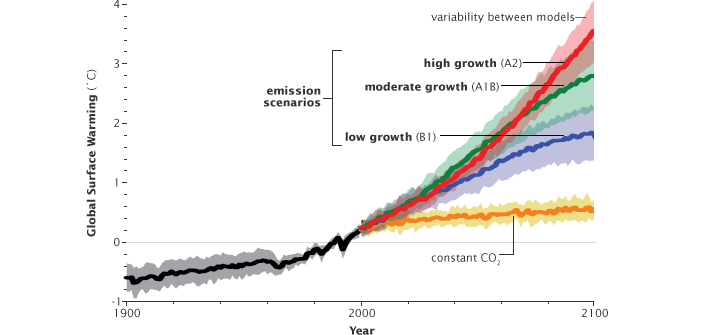
Model simulations by the Intergovernmental Panel on Climate change guess that Earth will warm betwixt two and half-dozen degrees Celsius over the next century, depending on how fast carbon dioxide emissions abound. Scenarios that presume that people volition fire more and more fossil fuel provide the estimates in the top end of the temperature range, while scenarios that assume that greenhouse gas emissions volition grow slowly give lower temperature predictions. The orangish line provides an estimate of global temperatures if greenhouse gases stayed at year 2000 levels. (©2007 IPCC WG1 AR-four.)
Climate Feedbacks
Greenhouse gases are only role of the story when it comes to global warming. Changes to 1 part of the climate system can crusade boosted changes to the style the planet absorbs or reflects free energy. These secondary changes are called climate feedbacks, and they could more than double the corporeality of warming acquired by carbon dioxide alone. The primary feedbacks are due to snow and ice, water vapor, clouds, and the carbon cycle.
Snowfall and water ice
Perhaps the almost well known feedback comes from melting snow and ice in the Northern Hemisphere. Warming temperatures are already melting a growing per centum of Arctic sea ice, exposing dark ocean h2o during the perpetual sunlight of summer. Snow encompass on land is too dwindling in many areas. In the absence of snow and ice, these areas go from having brilliant, sunlight-reflecting surfaces that cool the planet to having dark, sunlight-absorbing surfaces that bring more energy into the Earth system and cause more than warming.
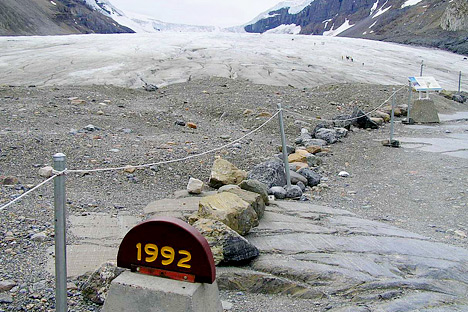
Canada's Athabasca Glacier has been shrinking by about 15 meters per year. In the past 125 years, the glacier has lost half its volume and has retreated more one.five kilometers. As glaciers retreat, sea ice disappears, and snow melts earlier in the bound, the Earth absorbs more than sunlight than information technology would if the reflective snow and ice remained. (Photo ©2005 Hugh Saxby.)
Water Vapor
The largest feedback is water vapor. Water vapor is a stiff greenhouse gas. In fact, because of its abundance in the atmosphere, water vapor causes about two-thirds of greenhouse warming, a cardinal gene in keeping temperatures in the habitable range on Earth. Merely as temperatures warm, more than water vapor evaporates from the surface into the temper, where it can cause temperatures to climb further.
The question that scientists ask is, how much h2o vapor will be in the temper in a warming globe? The temper currently has an boilerplate equilibrium or residue between h2o vapor concentration and temperature. As temperatures warm, the atmosphere becomes capable of containing more water vapor, and and so water vapor concentrations become up to regain equilibrium. Will that tendency concord as temperatures continue to warm?
The amount of water vapor that enters the atmosphere ultimately determines how much additional warming volition occur due to the h2o vapor feedback. The atmosphere responds quickly to the water vapor feedback. And so far, most of the temper has maintained a near constant residuum betwixt temperature and water vapor concentration as temperatures have gone up in recent decades. If this tendency continues, and many models say that it will, water vapor has the chapters to double the warming acquired past carbon dioxide alone.
Clouds
Closely related to the water vapor feedback is the cloud feedback. Clouds cause cooling by reflecting solar free energy, but they also cause warming by arresting infrared energy (like greenhouse gases) from the surface when they are over areas that are warmer than they are. In our electric current climate, clouds accept a cooling result overall, just that could change in a warmer surroundings.
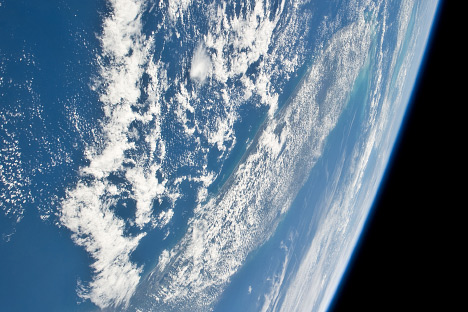
Clouds can both cool the planet (by reflecting visible light from the sun) and warm the planet (by absorbing heat radiation emitted past the surface). On balance, clouds slightly cool the Earth. (NASA Astronaut Photograph STS31-E-9552 courtesy Johnson space Eye Earth Observations Lab.)
If clouds become brighter, or the geographical extent of vivid clouds expands, they will tend to absurd Earth's surface. Clouds can become brighter if more than wet converges in a particular region or if more fine particles (aerosols) enter the air. If fewer bright clouds class, it will contribute to warming from the cloud feedback.
Meet Ship Tracks S of Alaska to learn how aerosols tin can brand clouds brighter.
Clouds, like greenhouse gases, also absorb and re-emit infrared free energy. Low, warm clouds emit more than energy than loftier, cold clouds. However, in many parts of the world, energy emitted by low clouds can be captivated by the arable h2o vapor above them. Further, depression clouds oft have nearly the aforementioned temperatures as the World'due south surface, and so emit like amounts of infrared energy. In a world without low clouds, the amount of emitted infrared energy escaping to space would not be too different from a world with depression clouds.
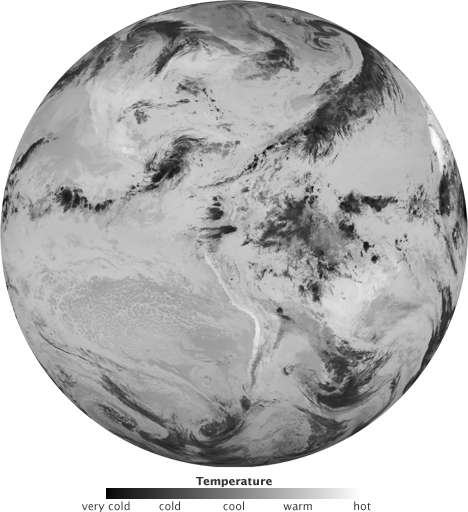
Clouds emit thermal infrared (heat) radiation in proportion to their temperature, which is related to altitude. This image shows the Western Hemisphere in the thermal infrared. Warm sea and land surface areas are white and low-cal grey; cool, low-level clouds are medium greyness; and cold, high-altitude clouds are night gray and black. (NASA image courtesy GOES Projection Scientific discipline.)
Loftier cold clouds, however, form in a part of the temper where energy-absorbing water vapor is deficient. These clouds trap (absorb) energy coming from the lower atmosphere, and emit little energy to space because of their frigid temperatures. In a globe with high clouds, a significant amount of energy that would otherwise escape to space is captured in the atmosphere. As a result, global temperatures are higher than in a earth without high clouds.
If warmer temperatures result in a greater amount of high clouds, then less infrared energy will be emitted to space. In other words, more high clouds would enhance the greenhouse effect, reducing the Earth'due south capability to cool and causing temperatures to warm.
Come across Clouds and Radiation for a more complete description.
Scientists aren't entirely certain where and to what caste clouds volition end upward amplifying or moderating warming, but most climate models predict a slight overall positive feedback or distension of warming due to a reduction in depression cloud cover. A recent observational written report found that fewer depression, dense clouds formed over a region in the Pacific Ocean when temperatures warmed, suggesting a positive cloud feedback in this region as the models predicted. Such direct observational evidence is limited, however, and clouds remain the biggest source of incertitude--apart from human choices to control greenhouse gases—in predicting how much the climate will change.
The Carbon Cycle
Increased atmospheric carbon dioxide concentrations and warming temperatures are causing changes in the Earth's natural carbon cycle that also tin feedback on atmospheric carbon dioxide concentration. For now, primarily ocean water, and to some extent ecosystems on land, are taking upwards about one-half of our fossil fuel and biomass burning emissions. This behavior slows global warming by decreasing the rate of atmospheric carbon dioxide increase, but that trend may not go along. Warmer ocean waters will hold less dissolved carbon, leaving more in the atmosphere.
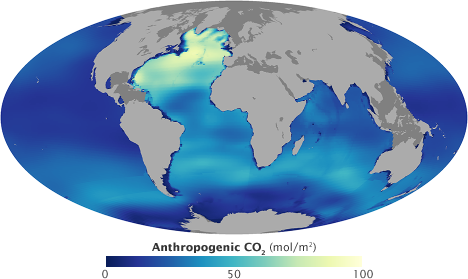
About half the carbon dioxide emitted into the air from called-for fossil fuels dissolves in the ocean. This map shows the total amount of human being-made carbon dioxide in ocean water from the surface to the sea floor. Blue areas have low amounts, while yellow regions are rich in anthropogenic carbon dioxide. High amounts occur where currents carry the carbon-dioxide-rich surface water into the ocean depths. (Map adapted from Sabine et al., 2004.)
See The Sea's Carbon Residue on the Earth Observatory.
On land, changes in the carbon cycle are more complicated. Under a warmer climate, soils, especially thawing Chill tundra, could release trapped carbon dioxide or methane to the atmosphere. Increased fire frequency and insect infestations also release more carbon equally copse burn or die and decay.
On the other paw, extra carbon dioxide tin can stimulate plant growth in some ecosystems, allowing these plants to take additional carbon out of the atmosphere. However, this effect may be reduced when plant growth is limited by h2o, nitrogen, and temperature. This upshot may also diminish as carbon dioxide increases to levels that become saturating for photosynthesis. Because of these complications, it is not articulate how much boosted carbon dioxide plants tin can take out of the atmosphere and how long they could proceed to do and then.
The impact of climate change on the state carbon cycle is extremely complex, but on balance, land carbon sinks volition become less efficient as plants reach saturation, where they can no longer take upwards additional carbon dioxide, and other limitations on growth occur, and every bit state starts to add more carbon to the temper from warming soil, fires, and insect infestations. This will result in a faster increase in atmospheric carbon dioxide and more rapid global warming. In some climate models, carbon cycle feedbacks from both land and ocean add together more than a degree Celsius to global temperatures by 2100.
Emission Scenarios
Scientists predict the range of likely temperature increase by running many possible time to come scenarios through climate models. Although some of the doubt in climate forecasts comes from imperfect knowledge of climate feedbacks, the most significant source of uncertainty in these predictions is that scientists don't know what choices people will brand to control greenhouse gas emissions.
The higher estimates are fabricated on the assumption that the entire world will go along using more than and more fossil fuel per capita, a scenario scientists call "business-equally-usual." More than pocket-sized estimates come from scenarios in which environmentally friendly technologies such as fuel cells, solar panels, and wind energy replace much of today'south fossil fuel combustion.
It takes decades to centuries for Earth to fully react to increases in greenhouse gases. Carbon dioxide, among other greenhouse gases, will remain in the atmosphere long after emissions are reduced, contributing to continuing warming. In addition, as Globe has warmed, much of the excess energy has gone into heating the upper layers of the bounding main. Like a hot water bottle on a common cold dark, the heated ocean will continue warming the lower atmosphere well afterwards greenhouse gases accept stopped increasing.
These considerations hateful that people won't immediately see the impact of reduced greenhouse gas emissions. Fifty-fifty if greenhouse gas concentrations stabilized today, the planet would continue to warm by most 0.6°C over the next century because of greenhouses gases already in the atmosphere.
Encounter Earth's Large Heat Bucket, Correcting Ocean Cooling, and Climate Q&A: If we immediately stopped emitting greenhouse gases, would global warming stop? to larn more almost the ocean oestrus and global warming.
How Will Global Warming Change Earth?
The impact of increased surface temperatures is significant in itself. But global warming will have boosted, far-reaching effects on the planet. Warming modifies rainfall patterns, amplifies coastal erosion, lengthens the growing season in some regions, melts ice caps and glaciers, and alters the ranges of some infectious diseases. Some of these changes are already occurring.
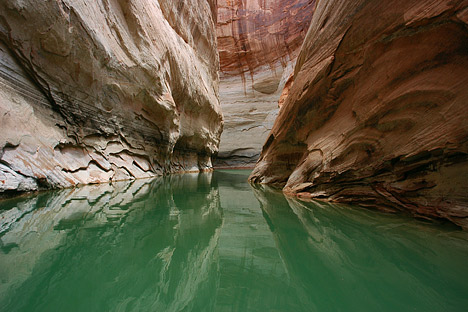
Global warming will shift major climate patterns, possibly prolonging and intensifying the current drought in the U.S. Southwest. The white ring of bleached rock on the in one case-cerise cliffs that hold Lake Powell indicate the drop in water level over the past decade—the result of repeated winters with low snow. (Photograph ©2006 Tigresblanco.)
Irresolute Weather
For most places, global warming will upshot in more than frequent hot days and fewer cool days, with the greatest warming occurring over land. Longer, more than intense oestrus waves volition become more common. Storms, floods, and droughts volition mostly be more severe every bit precipitation patterns change. Hurricanes may increase in intensity due to warmer sea surface temperatures.
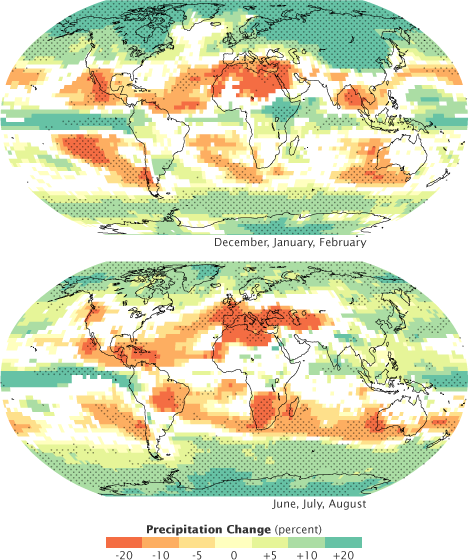
Autonomously from driving temperatures up, global warming is likely to cause bigger, more destructive storms, leading to an overall increase in precipitation. With some exceptions, the tropics volition likely receive less rain (orange) as the planet warms, while the polar regions volition receive more precipitation (light-green). White areas indicate that fewer than two-thirds of the climate models agreed on how atmospheric precipitation will change. Stippled areas reveal where more than 90 percent of the models agreed. (©2007 IPCC WG1 AR-4.)
Information technology is impossible to pin whatever single unusual weather issue on global warming, but emerging evidence suggests that global warming is already influencing the weather. Heat waves, droughts, and intense rain events accept increased in frequency during the last 50 years, and human-induced global warming more likely than not contributed to the trend.
Rising Sea Levels
The atmospheric condition isn't the only matter global warming will impact: rise bounding main levels will erode coasts and crusade more frequent coastal flooding. Some island nations will disappear. The problem is serious because up to 10 percent of the world's population lives in vulnerable areas less than ten meters (almost 30 feet) above sea level.
Between 1870 and 2000, the body of water level increased by 1.7 millimeters per year on boilerplate, for a total sea level rise of 221 millimeters (0.7 feet or 8.7 inches). And the charge per unit of ocean level ascent is accelerating. Since 1993, NASA satellites have shown that body of water levels are rising more than quickly, well-nigh 3 millimeters per twelvemonth, for a total ocean level rise of 48 millimeters (0.16 feet or 1.89 inches) between 1993 and 2009.

Ocean levels crept up virtually xx centimeters (seven.9 inches) during the twentieth century. Sea levels are predicted to go up between 18 and 59 cm (vii.1 and 23 inches) over the next century, though the increase could exist greater if ice sheets in Greenland and Antarctica melt more quickly than predicted. Higher sea levels will erode coastlines and cause more than frequent flooding. (Graph ©2007 Robert Rohde.)
The Intergovernmental Console on Climate Change (IPCC) estimates that sea levels will rise between 0.18 and 0.59 meters (0.59 to 1.9 feet) by 2099 as warming sea h2o expands, and mountain and polar glaciers melt. These body of water level change predictions may be underestimates, nevertheless, because they practice not business relationship for any increases in the rate at which the world's major ice sheets are melting. As temperatures ascent, water ice will melt more quickly. Satellite measurements reveal that the Greenland and Due west Antarctic ice sheets are shedding about 125 billion tons of ice per year—plenty to heighten sea levels by 0.35 millimeters (0.01 inches) per year. If the melting accelerates, the increase in sea level could be significantly higher.
Impacting Ecosystems
More chiefly, mayhap, global warming is already putting pressure on ecosystems, the plants and animals that co-be in a particular climate zone, both on country and in the ocean. Warmer temperatures have already shifted the growing flavor in many parts of the globe. The growing season in parts of the Northern Hemisphere became two weeks longer in the second half of the 20th century. Spring is coming before in both hemispheres.
This alter in the growing flavor affects the broader ecosystem. Migrating animals take to start seeking food sources earlier. The shift in seasons may already exist causing the lifecycles of pollinators, like bees, to be out of synch with flowering plants and trees. This mismatch can limit the power of both pollinators and plants to survive and reproduce, which would reduce food availability throughout the nutrient chain.
See Buzzing About Climate Change to read more about how the lifecycle of bees is synched with flowering plants.
Warmer temperatures besides extend the growing flavour. This means that plants need more water to keep growing throughout the flavour or they will dry out out, increasing the risk of failed crops and wildfires. Once the growing flavour ends, shorter, milder winters fail to impale fallow insects, increasing the hazard of big, damaging infestations in subsequent seasons.
In some ecosystems, maximum daily temperatures might climb beyond the tolerance of ethnic plant or animate being. To survive the farthermost temperatures, both marine and land-based plants and animals accept started to migrate towards the poles. Those species, and in some cases, entire ecosystems, that cannot rapidly migrate or arrange, face up extinction. The IPCC estimates that 20-thirty percent of establish and beast species will be at risk of extinction if temperatures climb more than than 1.v° to two.5°C.
Impacting People
The changes to weather and ecosystems volition also affect people more directly. Hardest hitting will be those living in low-lying coastal areas, and residents of poorer countries who do non take the resources to adapt to changes in temperature extremes and water resources. Every bit tropical temperature zones expand, the reach of some infectious diseases, such as malaria, volition alter. More than intense rains and hurricanes and rising sea levels volition lead to more severe flooding and potential loss of belongings and life.
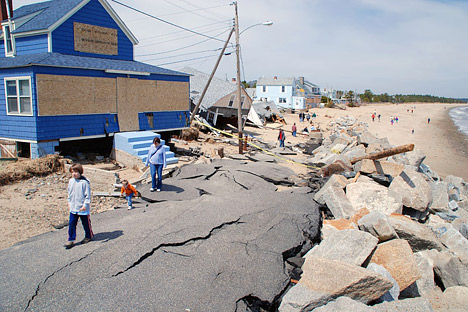
Ane inevitable event of global warming is bounding main-level rising. In the face up of higher sea levels and more than intense storms, coastal communities confront greater gamble of rapid beach erosion from subversive storms similar the intense nor'easter of Apr 2007 that caused this harm. (Photograph ©2007 metimbers2000.)
Hotter summers and more frequent fires will lead to more cases of oestrus stroke and deaths, and to higher levels of almost-surface ozone and smoke, which would cause more 'lawmaking cherry' air quality days. Intense droughts can lead to an increase in malnutrition. On a longer time calibration, fresh water volition become scarcer, especially during the summer, as mountain glaciers disappear, particularly in Asia and parts of North America.
On the flip side, there could be "winners" in a few places. For case, equally long every bit the rise in global average temperature stays below 3 degrees Celsius, some models predict that global food production could increase considering of the longer growing flavor at mid- to high-latitudes, provided acceptable h2o resource are available. The aforementioned small alter in temperature, however, would reduce food production at lower latitudes, where many countries already face food shortages. On balance, most research suggests that the negative impacts of a changing climate far outweigh the positive impacts. Current civilization—agriculture and population distribution—has developed based on the current climate. The more the climate changes, and the more quickly it changes, the greater the toll of adaptation.
Ultimately, global warming will impact life on Earth in many ways, but the extent of the change is largely up to us. Scientists have shown that man emissions of greenhouse gases are pushing global temperatures up, and many aspects of climate are responding to the warming in the way that scientists predicted they would. This offers hope. Since people are causing global warming, people tin can mitigate global warming, if they act in fourth dimension. Greenhouse gases are long-lived, so the planet will continue to warm and changes will continue to happen far into the hereafter, but the caste to which global warming changes life on Earth depends on our decisions at present.
-
References
- Anthes, R.A., Corell, R.Westward., Kingdom of the netherlands, G., Hurrell, J.W., MacCracken, 1000.C., & Trenberth, M. (2010, February 12). Hurricanes and Global Warming—Potential Linkages and Consequences. Bulletin of the American Meteorological Social club, 87: 623-628. Accessed April fifteen, 2010.
- Arctic Council. (2004). Arctic Climate Impact Assessment Report. Accessed March 22, 2007.
- Balachandran, N., Rind, D., Lonergan, P., & Shindell, D. (1999). Furnishings of solar cycle variability on the lower stratosphere and the troposphere. Journal of Geophysical Research, 104(D22), 27, 321-327, 339.
- Bender, M. A., Knutson, T. R., Tuleya, R. E., Sirutis, J. J., Vecchi, G. A., Garner, Southward. T., and Held, I. M. (2010). Modeled Affect of Anthropogenic Warming on the Frequency of Intense Atlantic Hurricanes. Science, 327(5964), 454-458.
- Bonan, G. B. (2008). Forests and Climate Change: Forcings, Feedbacks, and the Climate Benefits of Forests. Science, 320(5882), 1444-1449.
- Cazenave, A. (2006). How fast are the ice sheets melting? Science, 314, 1251-1252.
- Clement, A.C., Burgman, R., Norris, J.R. (2009, July 24) Observational and model evidence for positive low-level cloud feedback. Scientific discipline, 325 (5939), 460-464.
- Dessler, A., Zhang, Z., Yang, P. (2008, Oct 23). Water-vapor climate feedback inferred from climate fluctuations, 2003-2008. Geophysical Research Letters, 35, L20704.
- Emanuel, 1000. (2005). Increasing destructiveness of tropical cyclones over the past 30 years. Nature, 436, 686-688.
- Foucal, P., Frölich, C., Spruit, H., and Wigley, T. (2006). Variations in solar luminosity and their issue on the Earth'due south climate. Nature, 443, 161-166.
- Hansen, J., Sato, M., Ruedy, R., Kharecha, P., Lacis, A., Miller, R., Nazarenko, L., et al. (2007). Climate simulations for 1880–2003 with GISS model Eastward. Climate Dynamics, 29(7), 661-696.
- Hansen, J., Nazarenko, Fifty., Ruedy, R., Sato, K., Willis, J., Del Genio, A., Koch, D., Lacis, A., Lo, K., Menon, Southward., Novakov, T., Perlwitz, J., Russell, G., Schmidt, Yard.A., and Tausnev, N. (2005, June 3). Earth's free energy imbalance: confirmation and implications. Science, 308, 1431-1435.
- Intergovernmental Panel on Climatic change. (2007). Climatic change 2007: The Physical Scientific discipline Ground Summary for Policymakers. A Report of Working Group 1 to the 4th Cess Report of the Intergovernmental Panel on Climate change.
- Intergovernmental Panel on Climatic change. (2007). Climatic change 2007: Climatic change Impacts, Adaptation and Vulnerability Summary for Policymakers. A Report of Working Group Two to the Fourth Assessment Report of the Intergovernmental Console on Climate change.
- Joint Science Academies. (2005). Joint Scientific discipline Academies' Statement: Global Response to Climate Change. June 2005.
- Jouzel, J., Masson-Delmotte, V., Cattani, O., Dreyfus, 1000., Falourd, Due south., Hoffmann, 1000., Minster, B., et al. (2007). Orbital and Millennial Antarctic Climate Variability over the By 800,000 Years. Science, 317(5839), 793-796.
- Labitzke, Thousand., Butchart, Due north., Knight, J., Takahashi, M., Nakamoto, Chiliad., Nagashima, T., Haigh, J., et al. (2002). The global bespeak of the 11-yr solar cycle in the stratosphere: observations and models. Periodical of Atmospheric and Solar-Terrestrial Physics, 64(ii), 203-210.
- Laštovička, J., Akmaev, R. A., Beig, 1000., Bremer, J., & Emmert, J. T. (2006). Atmosphere: Global Alter in the Upper Atmosphere. Science, 314(5803), 1253-1254.
- Lau, K. M., and H. T. Wu. (2007). Detecting trends in tropical rainfall characteristics, 1979-2003. International Journal of Climatology, 27.
- Lean, J. 50., & Rind, D. H. (2009). How volition Earth's surface temperature change in future decades? Geophysical Inquiry Letters, 36, L15708.
- Lean, J. L., & Rind, D. H. (2008). How natural and anthropogenic influences alter global and regional surface temperatures: 1889 to 2006. Geophysical Research Messages, 35(xviii).
- Luthcke, S.B., Zwally, H.J., Abdalati, W., Rowlands, D.D., Ray, R.D., Nerem, R.S., Lemoine, F.Yard., McCarthy, J.J., and Chinn, D.Southward. (2006). Recent Greenland ice mass loss by drainage system from satellite gravity observations. Scientific discipline, 314, 1286-1289.
- Isle of mann, M. Eastward., Zhang, Z., Hughes, 1000. K., Bradley, R. Southward., Miller, Southward. Yard., Rutherford, Due south., & Ni, F. (2008). Proxy-based reconstructions of hemispheric and global surface temperature variations over the past two millennia. Proceedings of the National Academy of Sciences, 105(36), 13252-13257.
- Manvendra 1000. Dubey, Petr Chylek, Charlie S. Zender, & Chris K. Folland. (2010, February 12). Global Warming and the Adjacent Ice Age. Bulletin of the American Meteorological Society, 89 (12), 1905-1909.
- McGranahan, Grand., D. Balk and B. Anderson. (2007). The rise tide: assessing the risks of climate change and human settlements in depression elevation coastal zones. Surround & Urbanization, 19 (i), 17-37.
- Millennium Ecosystem Assessment, 2005. Ecosystems and Human Well-being: Synthesis. Island Press, Washington, DC.
- Oren, R., Ellsworth, D. S., Johnsen, Grand. H., Phillips, N., Ewers, B. E., Maier, C., Schafer, Thousand. V., et al. (2001). Soil fertility limits carbon sequestration by forest ecosystems in a CO2-enriched temper. Nature, 411(6836), 469-472.
- Ramanathan, V., & Feng, Y. (2008). On avoiding dangerous anthropogenic interference with the climate organisation: Formidable challenges ahead. Proceedings of the National Academy of Sciences, 105(38), 14245-14250.
- Rind, D., Lean, J.L., Lerner, J., Lonergan, P., and Leboissetier, A. (2008). Exploring the stratospheric/tropospheric response to solar forcing. Journal of Geophysical Enquiry, 113, D24103.
- Robock, A., Marquardt, A., Kravitz, B., & Stenchikov, K. (2009). Benefits, risks, and costs of stratospheric geoengineering. Geophysical Research Letters, 36, L19703.
- Sabine, C. 50. (2004). The Oceanic Sink for Anthropogenic CO2. Science, 305(5682), 367-371.
- Schimel, D. (2007). Carbon bike conundrums. Proceedings of the National Academy of Sciences, 104(47), 18353-18354.
- Seager, R., Ting, Grand., Held, I., Kushnir, Y., Lu, J., Vecchi, G., Huang, H., et al. (2007). Model Projections of an Imminent Transition to a More Arid Climate in Southwestern North America. Scientific discipline, 316(5828), 1181-1184.
- Shepherd, A., and Wingham, D. (2007). Recent bounding main-level contributions of the Antarctic and Greenland Water ice Sheets. Science, 315, 1529-1532.
- Soden, B. J. and Held, I.G. (2006, July). An assessment of climate feedbacks in coupled sea-atmosphere models. Periodical of Climate, 19: 3354-3360.
- Stainforth, D. A., Aina, T., Christensen, C., Collins, Yard., Faull, N., Frame, D. J., Kettleborough, J. A., et al. (2005). Dubiousness in predictions of the climate response to rising levels of greenhouse gases. Nature, 433(7024), 403-406.
- U.S. Climate Modify Science Plan. (April 2006). Temperature Trends in the Lower Atmosphere. Accessed April thirteen, 2007.
- U.Due south. Environmental Protection Bureau. (2007). Climate change. Accessed March 22, 2007.
- U.Southward. Geological Survey. (2009, Dec 29). Volcanic gases and their effects. Volcano Hazards Program. Accessed March 29, 2010.
- Velicogna, I., and Wahr, J., (2006). Measurements of fourth dimension-variable gravity show mass loss in Antarctica. Scientific discipline, 311 (5768), 1754-1756.
- Weir, J. (2002, Apr 8). Global Warming. Earth Observatory. Accessed Apr xiii, 2007.
-
Related Reading
- United states Global Modify Inquiry Program.
- Existent Climate
Source: https://www.earthobservatory.nasa.gov/features/GlobalWarming
0 Response to "How Warm Can It Be and Still Snow"
Post a Comment